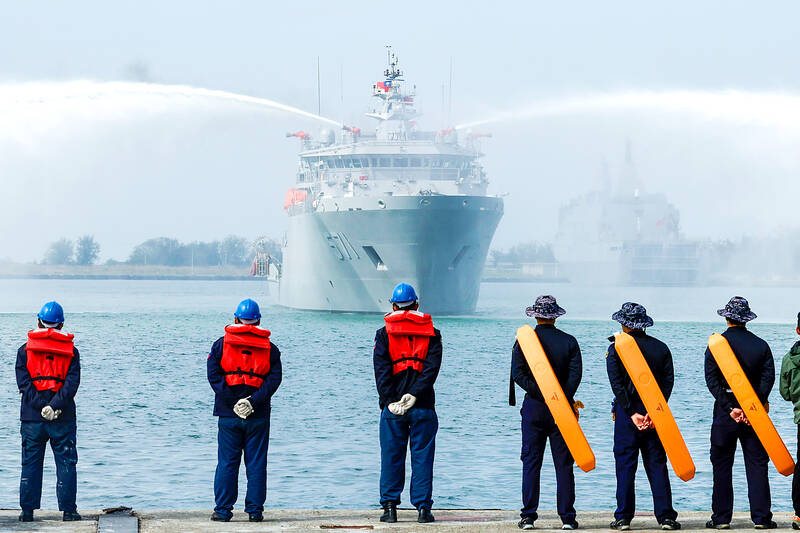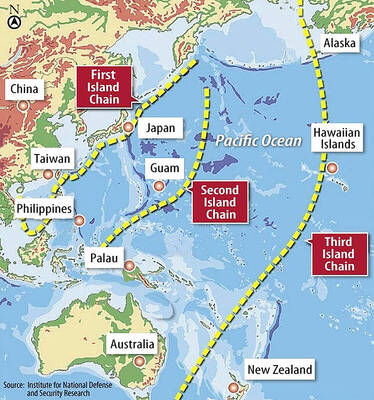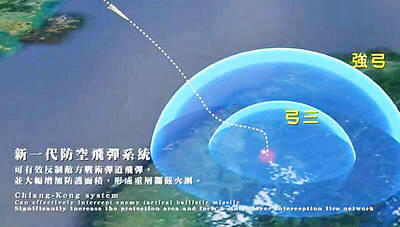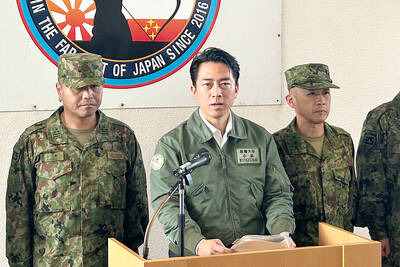The Ministry of National Defense yesterday declined to say whether Taiwan is pursuing a multibillion-dollar weapons purchase from the US, after sources briefed on the matter said that officials are in talks with Washington to procure at least US$7 billion of arms.
Three sources familiar with the situation, speaking on condition of anonymity given the sensitivity of the situation, told Reuters that Taiwan is in talks with Washington.
The package is meant to demonstrate to the US that Taiwan is committed to its defense, one of the sources said.

Photo: Ritchie B. Tongo, EPA-EFE
A second source said the package would include coastal defense cruise missiles and High Mobility Artillery Rocket Systems.
“I would be very surprised if it was less than US$8 billion. Somewhere between US$7 billion and US$10 billion,” the source added.
The White House did not immediately respond to a request for comment.
However, US National Security Adviser Mike Waltz has said he wants to speed up delivery of weapons to Taiwan.
The ministry declined to comment on specific purchases, but said it is focused on building its defenses.
“Any weaponry and equipment that can achieve those goals for building the military are listed as targets for tender,” said Major General Weng Yu-heng (翁予恒) from the Department of Strategic Planning.
The ministry would plan a special budget based on the threats posed by enemies, how urgently certain types of weapons are needed, production capacity and estimated delivery schedules, Weng added.
However, a third source said that Taiwan plans to propose a special defense budget that prioritizes precision ammunition, air defense upgrades, command and control systems, equipment for reserve forces and anti-drone technology.
Another ministry source told the Chinese-language Liberty Times (the Taipei Times’ sister paper) that the military is assessing measures to bolster the nation’s resilience, including projects related to armed forces reserves, asymmetric capabilities, precision-guided munition stockpiles, and intelligence surveillance and reconnaissance capabilities in the air and sea.
Following a national security meeting on Friday last week, President William Lai (賴清德) said that he would prioritize efforts to plan a special budget to raise Taiwan’s national defense budget to 3 percent of GDP to bolster its self-defense capabilities.
During his first term from 2017 to 2021, US President Donald Trump made regular arms sales to Taiwan, including multibillion dollar deals for F-16 jets.
The administration of former US president Joe Biden continued those sales, although often with smaller price tags.
Taiwan does not believe Trump is looking to make a “grand bargain” with Chinese President Xi Jinping (習近平) to sell out Taiwan’s interests, one of the sources said.
Trump is more concerned with putting tariffs on semiconductors, the source said.
In another sign of US commitment to Taiwan, American Institute in Taiwan Director Raymond Greene is to retain his post, three sources told Reuters, even as other US diplomatic postings undergo major reshuffles.
Additional reporting by Su Yung-yao and CNA

LIMITS: While China increases military pressure on Taiwan and expands its use of cognitive warfare, it is unwilling to target tech supply chains, the report said US and Taiwan military officials have warned that the Chinese People’s Liberation Army (PLA) could implement a blockade within “a matter of hours” and need only “minimal conversion time” prior to an attack on Taiwan, a report released on Tuesday by the US Senate’s China Economic and Security Review Commission said. “While there is no indication that China is planning an imminent attack, the United States and its allies and partners can no longer assume that a Taiwan contingency is a distant possibility for which they would have ample time to prepare,” it said. The commission made the comments in its annual

DETERMINATION: Beijing’s actions toward Tokyo have drawn international attention, but would likely bolster regional coordination and defense networks, the report said Japanese Prime Minister Sanae Takaichi’s administration is likely to prioritize security reforms and deterrence in the face of recent “hybrid” threats from China, the National Security Bureau (NSB) said. The bureau made the assessment in a written report to the Legislative Yuan ahead of an oral report and questions-and-answers session at the legislature’s Foreign Affairs and National Defense Committee tomorrow. The key points of Japan’s security reforms would be to reinforce security cooperation with the US, including enhancing defense deployment in the first island chain, pushing forward the integrated command and operations of the Japan Self-Defense Forces and US Forces Japan, as

INTERCEPTION: The 30km test ceiling shows that the CSIST is capable of producing missiles that could stop inbound missiles as they re-enter the atmosphere Recent missile tests by the Chungshan Institute of Science and Technology (CSIST) show that Taiwan’s missiles are capable of intercepting ballistic missiles as they re-enter the atmosphere and pose a significant deterrent to Chinese missile threats, former Hsiung Feng III missile development project chief engineer Chang Cheng (張誠) said yesterday. The military-affiliated institute has been conducting missile tests, believed to be related to Project Chiang Kung (強弓) at Pingtung County’s Jiupeng Military Base, with many tests deviating from past practices of setting restriction zones at “unlimited” and instead clearly stating a 30.48km range, Chang said. “Unlimited” restrictions zones for missile tests is

IN THE NATIONAL INTEREST: Deputy Minister of Foreign Affairs Francois Wu said the strengthening of military facilities would help to maintain security in the Taiwan Strait Japanese Minister of Defense Shinjiro Koizumi, visiting a military base close to Taiwan, said plans to deploy missiles to the post would move forward as tensions smolder between Tokyo and Beijing. “The deployment can help lower the chance of an armed attack on our country,” Koizumi told reporters on Sunday as he wrapped up his first trip to the base on the southern Japanese island of Yonaguni. “The view that it will heighten regional tensions is not accurate.” Former Japanese minister of defense Gen Nakatani in January said that Tokyo wanted to base Type 03 Chu-SAM missiles on Yonaguni, but little progress